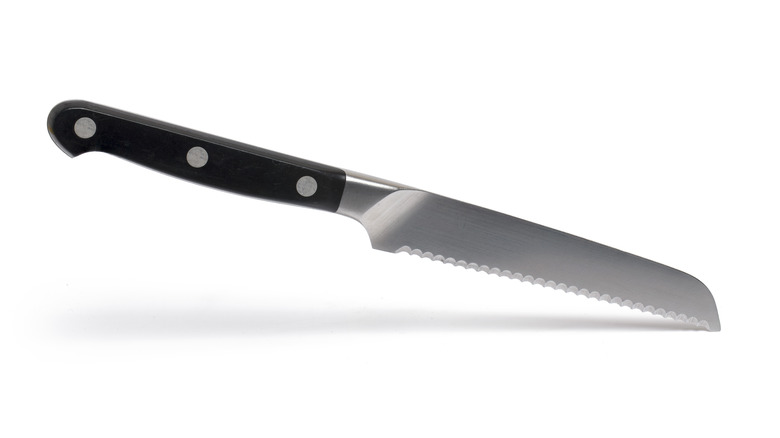The Crucial Knife Tip For Perfectly Shaped Potato Skins
Potato skins are the ultimate snack — they're crispy, creamy, salty, and, best of all, filling. But to sate the eater, the skins must be filled in return. The dish's few perfect bites can be had by holding it by the skin with one hand on game days or devouring it more demurely at a Chili's with a knife and fork.
According to Kitchn, whipping one up involves rubbing potatoes with oil and salt and baking them whole while frying a pan of bacon. After cooling, the potatoes are cut in half, and the majority of the whitish-yellow flesh is scooped gently from the skin and saved for another meal. They then get brushed all over with the fat from the bacon you saved and put back into the oven until satisfyingly crisped.
It's at this point that the scoops can be topped with shredded cheddar cheese and broiled until melted. To finish, add a crumble of cooked bacon, a spoonful of sour cream, and a sprinkle of chopped scallions to top each one, and serve them hot and crunchy. And if you thought it didn't get any better, the recipe for this bar food classic can easily be tweaked. Add some salsa to go in a more Southwest direction, or whip up some carrot bacon to make it vegetarian. By far, the hardest part of making potato skins is turning whole potatoes into little boats, but a couple of knife tricks will ensure you're never with a busted potato.
Get out a serrated and paring knife
The best potato to use for potato skins is the large, floury Russet, as opposed to the waxy Red Bliss or New varieties that are better suited for boiling (via Bon Appétit). America's Test Kitchen agrees, preferring them because of their thick skin. Russets offer the contrast of a crispy texture to a tender flesh. However, as sturdy and unfussy as they seem, they can easily fall apart in your hands.
One of the first pitfalls you can encounter when making the dish is when you're halving your baked potatoes. Chef's knives have a tendency to catch and tear the skins of the potato, so Kitchn recommends using a long serrated bread knife instead.
Once you've got your halves and are ready to take out the flesh, rather than immediately reaching for a spoon, the outlet recommends using the tip of a paring knife to outline the area you plan to scoop out — this should be about a quarter inch from the edge. Digging straight in with a spoon could lead you to push through the skin and the knife creates a perforation so the spoon naturally follows the cut. Now that we're all equipped with this tip, let's bring this appy back to its 80s glory.

